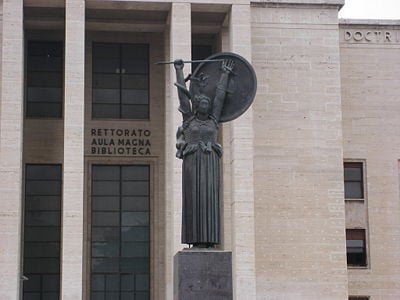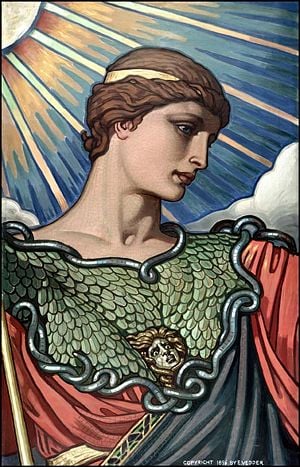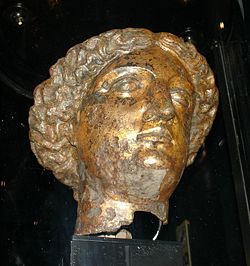Minerva
Minerva was a Roman goddess of crafts, poetry and wisdom, medicine and is known as the inventor of music. She was considered to be the virgin goddess of warriors, poetry, medicine, wisdom, commerce, crafts, and the inventor of music. As Minerva Medica, she was the goddess of medicine and doctors. Like many of the figures of Roman mythology, Minerva's character and function was largely appropriated from the Greek tradition, and she is similar to virtually identical to Athena, the goddess of wisdom and warriors in the Greek pantheon.
History
Minerva probably began as a local Italian goddess, although she was not worshipped in Rome as early as other dieties such as Jupiter and Juno.[1] She first appears in the Capitoline temple, indicative of the fact that she was imported to the Romans from the Etruscans. Accordingly, her name is virtually identical to that of the the Etruscan goddess of the arts Menrva. The Romans would have easily confused her foreign name with their word mens meaning "mind" since one of her aspects as goddess pertained not only to war but also to the intellectual. The name "Minerva" may also derive from the Indo-European root 'men', from which the English words "mental" and "mind" are also derived.
It was only when she was identified with the Greek goddess Athena did she gain the character as a goddess of war and combat. Although it is hard to distinguish her original function before she inherited the legends of Athena, they were likely those of a war goddess, as well. Like Athena, Minerva came to be represented in art bearing a weapon and armour, and shared her primary festival with Mars, another war diety. In Rome, however she was worshipped more prominently as a goddess of all activities involving mental adeptness, such as handicrafts, writing and artistic endeavours. She was also the Roman goddess of school children.[2]
Mythology
Adapting Greek myths about Athena, Romans said that Minerva was not born in the usual way, but rather Jupiter had a horrible headache and Vulcan opened up his head and out came Minerva, fully grown, and dressed in armor, a long trailing robe, a helmet, a shield and a spear.
Minerva was greatly skilled in the practice of weaving, and grew somewhat perturbed when she learned that a woman by the name of Arachne had skill with wool which equalled her own. This situation was exacerbated by the fact that Arachne boasted her skills were superior to Minerva, and gave the wise warrior goddess no credit for her successes. Minerva disguised herself as an aged woman and warned Arachne that she was best not to challenge the gods. Arachne ignored the advice and openly challenged Minerva. At this point, Minerva threw aside her disguise and revealed her divine identity, and bid that the competition should begin. Both she and Arachne wove elaborate tapestries dedicated to the myths of Rome, Minerva depicting scenes where mortals challenged the gods and Arachne depicting their more lecherous conquests. In the end, Minerva inspected Arachne's work and found it to be perfect. In a jealous rage, she tore up Arachne's tapestry, and the mortal woman hung herself in the wake of her grief. Taking a measure of pity on the girl, Minerva transformed Arachne into a spider.
Minerva is also credited with the invention of music, which corresponded to her construction of the double flute from a stag's bones. Although the first notes she played on this instrument were delightful to the ear, Juno and Venus mocked the sound that issued forth. Afterwards, Minerva sat down beside a quiet pool of water and played her flute again. In the water before her, she saw how her cheeks puffed out comically with each breath she took into the flute, and promptly threw her invention aside, placing a curse of death on whosoever should pick it up.
Worship
Minerva was worshipped throughout Italy, though only in Rome did she take on a warlike character. Her worship was also taken out to the empire - in Britain, for example, she was conflated with the wisdom goddess Sulis. Minerva was also worshipped on the Capitoline Hill as one of the Capitoline Triad along with Jupiter and Juno, at the Temple of Minerva Medica, and at the "Delubrum Minervae" a temple founded around 50 B.C.E. by Pompey on the site of the church of Santa Maria sopra Minerva (near the present-day Piazza della Minerva and the Pantheon).
The Romans celebrated her festival from March 19 to March 23 during the day which is called, in the feminine plural, Quinquatria, the fifth after the Ides of March, the nineteenth, the artisans' holiday. A lesser version, the Minusculae Quinquatria, was held on the Ides of June, June 13, by the flute-players, who were particularly useful to religion. In 207 B.C.E., a guild of poets and actors was formed to meet and make votive offerings at the temple of Minerva on the Aventine hill. Among others, its members included Livius Andronicus. The Aventine sanctuary of Minerva continued to be an important center of the arts for much of the middle Roman Republic. However, with the acknowledgement of Christianity as the state religion of Rome in the 4th century, worship of the various polytheistic dieties including Minerva faded into oblivion.
Interestingly enough, worship of Minerva resurfaced in the early 20th century in Gautemala, of all places. During this time, Manuel José Estrada Cabrera, President of Guatemala, tried to promote a "Cult of Minerva" in his country. This movement left little legacy other than a few interesting Hellenic style "Temples" in parks around Guatemala.
Temples
Several famous temples dedicated to the goddess Minerva once existed in the ancient world, especially in Rome. The temple of Minerva Medica (akin to the temple of Apollo Medicus) was built on the Esquiline Hill in the republican era (510 B.C.E. - 1st century B.C.E.) and is often referenced in literary works of that time period, though no remains of it have been found. It has since the 17th century been wrongly identified with the ruins of the Temple of Minerva Medica (nymphaeum), a nymphaeum on a nearby site, on account of the erroneous impression that the Athena Giustiniani, an Antonine Roman marble copy of a Greek sculpture of Pallas Athena, had been found among its ruins.
The site of another ancient Minerva Temple in Rome is now today a famous Christian church. The Santa Maria sopra Minerva is a basilica church in Rome, which gets its name because, like many early Christian basilicas, it was built directly over (sopra) the foundations of a temple dedicated to the goddess Minerva. Details of the ruined temple to Minerva, built by Pompey about 50 B.C.E., referred to as Delubrum Minervae are not known. In Assisi, another church of Santa Maria sopra Minerva was built in the 16th century within the surviving cella of a late Republican temple of Minerva. Its Corinthian portico still stands.
Influence

Although Minerva is no longer worshipped, she has persisted as one of the Roman dieties most commonly alluded to among the cogniscenti and their folds. As patron goddess of wisdom, Minerva is frequently featured at educational establishments in the form of a statue, or as an image on seals, among other forms. For example, a statue of Minerva is located in the center of La Sapienza University, the most important university of Rome. Minerva is also displayed in front of Columbia University's Low Library as "Alma Mater." Minerva decorates the keystone over the main entrance to the Boston Public Library, the original public-financed library in America, beneath the words, "Free to all." Minerva is featured on the seals and logos of many institutions of higher learning, such as the University of Lincoln in the United Kingdom, the University at Albany, The State University of New York, the University of Alabama and Union College, New York, among others. Minerva is the logo of the world famous German "Max Planck Society for the Advancement of Science".
Minerva is also alluded to in numerous academic publications and literary works. For instance, Minerva is a triannual magazine for members of the Royal Dublin Society. Minerva is also a section heading in the British Medical Journal, alluding to her healing powers. In a similar vein, Minerva Medica is the name of an Italian publisher of medical journals and books. The journal of the Special Air Service Regiment of the British Army is "Mars and Minerva", taking its name from the regimental badge of the Artists' Rifles. Numerous literary and popular fictional characters, have been named after Minerva, usually related to computers or genius.
Notes
ReferencesISBN links support NWE through referral fees
- Grant, Michael & Hazel, John. Who's Who in Classical Mythology. London: Weidenfeld & Nicolson, 1973. ISBN 0297766007
- Grimal, Pierre. A Concise Dictionary of Classical Mythology. Cambridge, M.A.: Blackwell, 1990. ISBN 0631166963
- Lenardon, Robert J, et al. A Companion to Classical Mythology. New York: Oxford University Press, 1996. ISBN 978-0195147254
- Morford, Mark P. O. & Lenardon, Robert J. Classical Mythology. New York: Oxford University Press, 2002. ISBN 978-0195153446
- Scheid, John. An Introduction to Roman Religion. Bloomington, I.N.: Indiana University Press, 2003. ISBN 0253216605
External Links
Credits
New World Encyclopedia writers and editors rewrote and completed the Wikipedia article in accordance with New World Encyclopedia standards. This article abides by terms of the Creative Commons CC-by-sa 3.0 License (CC-by-sa), which may be used and disseminated with proper attribution. Credit is due under the terms of this license that can reference both the New World Encyclopedia contributors and the selfless volunteer contributors of the Wikimedia Foundation. To cite this article click here for a list of acceptable citing formats.The history of earlier contributions by wikipedians is accessible to researchers here:
- Minerva history
- Santa_Maria_sopra_Minerva history
- Temple_of_Minerva_Medica history
- Temple_of_Minerva_Medica_(temple) history
The history of this article since it was imported to New World Encyclopedia:
Note: Some restrictions may apply to use of individual images which are separately licensed.


